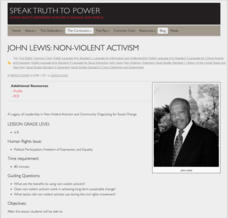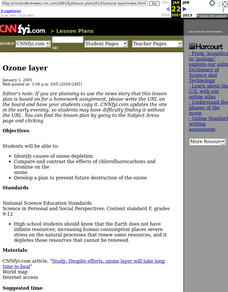Curated OER
Move It!!!
Students explore motion by observing the movement of people and duplicating those movements. They compare and contrast various kinds of movements and identify different types of movements in pictures. They build an object that can be...
Curated OER
Career Magic
Fifth graders gather information about the roles, responsibilities, skills, and training and education requirements of workers. Then they input this information into a graphic organizer chart and identify the similarities and differences...
Curated OER
Venn Diagram-Paleolithic and Neolithic
Review the paleolithic and neolithic time periods using this creative instructional activity. After a unit on Mesopotamia and the Stone Age, learners fill out a Venn diagram comparing the paleolithic and neolithic period, and write a...
Curated OER
Applying Elements of the Graphic Novel to Traditional Literature
The Khaled Hosseini Foundation, dedicated to providing humanitarian assistance for the people of Afghanistan, provides a series of exercises designed to be used with a reading of the graphic novel version of Hosseini’s The Kite Runner....
Hawaiʻi State Department of Education
Color Moods
Can art be a mode of communication? You bet it can! Learners explore how colors are used to convey mood in art. First, the class listens to three very unique musical selections that convey three different moods. Then, they compare and...
iCivics
Separation of Powers
In a fun and informative simulation, your learners will act in groups as lead chefs, menu writers, and nutrition inspectors in deciding a new school lunch menu. They will then compare and contrast their experience to the interaction...
Speak Truth to Power
John Lewis: Non-Violent Activism
After comparing and contrasting non-violent and violent social movements, your young historians will take a closer look at the work and influence of John Lewis on the civil rights movement. They will then choose a current social justice...
Museum of Tolerance
The Role of Citizens in a Participatory Democracy
Groups research participatory democracies and compare the role and rights of citizens in ancient history with those in recent U.S. history. Guided by a series of questions, individuals compose a persuasive essay in which they discuss the...
Hawaiʻi State Department of Education
Changing Scapes
Culture and art are two things that change with time and context. Learners compare and contrast two landscape prints from different time periods. They work through art terminology to help them describe what they see in each piece. The...
Curated OER
Faking It
Middle school earth scientists describe the behavior of the Coriolis force. They compare and contrast conditions under which the Coriolis force has a significant impact with conditions under which it has very little. They model the...
Curated OER
Ozone Layer
High schoolers read a CNNfyi.com article in order to identify causes of ozone depletion. They compare and contrast the effects of chlorofluorocarbons and bromine on the ozone. They develop a plan to prevent future destruction of the ozone.
Curated OER
Abstract painting - Inspired by Textiles
Students compare and contrast various forms of artistic expression associated with specific groups of people, geographic regions, or time periods, specifically art of Andean cultures, and create art works using procedures borrowed from...
Curated OER
Let's go to the Video Tape!
Using actual data from a deep-sea video survey, high school marine biologists consider the biodiversity, compare species richness between two communities, and learn to calculate the diversity index. The lesson plan is all-inclusive,...
Curated OER
Drafting the Gettysburg Address
Students, in groups, compare and contrast Abraham Lincoln's drafts and final version of the Gettysburg Address. They explain the differences between the final version and drafts of the Gettysburg Address.
Curated OER
Learning From World War II and Connecting It to the Present
Compare and contrast World War II to the modern Iraq war with this instructional activity. After watching a film, learners use supporting evidence to support their point of view of the conflicts. Using the internet, they create a...
Curated OER
Pizza! Pizza!
Third graders tally, sort, and organize pizza orders from monthly school sales. They create an advertising campaign to promote the School Pizza Sale, record the data in graph form, compare and contrast the tallies throughout the year,...
Curated OER
What do you know about earthquakes??
Ninth graders compare and contrast various writing styles and distinguish technical writing from other writing techniques. They assess personal knowledge regarding earthquakes and earthquake preparedness.
Curated OER
Feelin' Buggy
Students discuss five senses, compare and contrast human and insect senses, use adjectives to describe things they touch, smell, and see, and write stories in first person describing what it would be like to be size of insect.
Curated OER
The Ancient Art of Shadow Puppet Plays
Shadow puppetry has an ancient past, it is also a great way to build oral expression and reading fluency. Young thespians research folk tales, compare and contrast reality and fantasy, then create and perform a shadow puppet play based...
National Endowment for the Humanities
Jacob Lawrence's Migration Series: Removing the Mask
Describe, analyze, compare and contrast poets from the Harlem Renaissance. Critical thinkers analyze the imagery, characterization, tone, symbolism, and historical context of Jacob Lawrence, Helene Johnson, and Paul Laurence Dunbar. A...
Science Friday
Microorganisms on the Move
You can't b. cereus until you see this lesson! Young microbiologists learn to prepare deep well slides, observe two types of microorganisms, and compare and contrast their physical characteristics in this interactive and lively activity.
Science Friday
Colorful Chromosomes
Everything is in the genes. Individuals observe 14 different traits of themselves. Using pipe cleaners and beads, the learners create models of a chromosome representing their traits. The class then compares and contrasts everyone's...
EngageNY
Inferring About Characters Based on How They Respond to Challenges (Chapter 4: "Los Higos/Figs")
How do you know what a character's personality is like if an author doesn't tell you? With a focus on character development in Esperanza Rising, pupils complete a jigsaw activity to analyze the actions of Mama, Abuelita, and Miguel. Once...
Curated OER
Mozart vs. Beethoven - Real Classical Composers
Elementary schoolers are given an overview of the baroque, classical, romantic, and modern periods of music. They focus on the lives of Beethoven and Mozart; two of the greatest composers of all time. After listening to samples their...
Other popular searches
- Reading Compare and Contrast
- Compare and Contrast Essay
- Compare & Contrast Essays
- Compare and Contrast Writing
- Compare and Contrast Lesson
- Compare and Contrast Themes
- Compare Contrast Myth Fable
- Compare Contrast Essay
- Compare Contrast Paragraphs
- Compare and Contrast Math
- Compare and Contrast Setting
- Christmas Compare Contrast

























